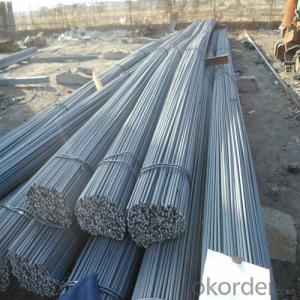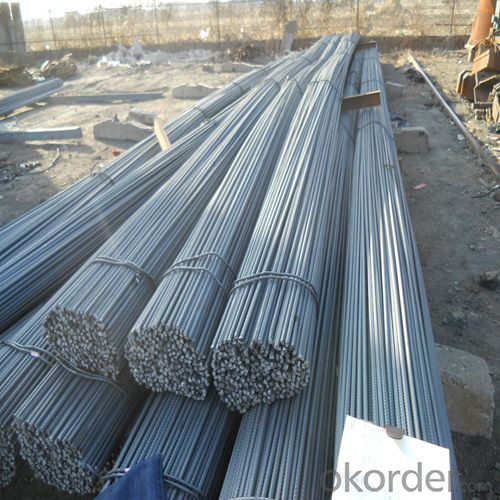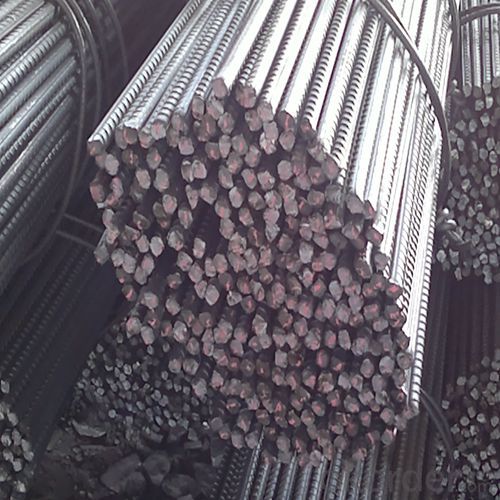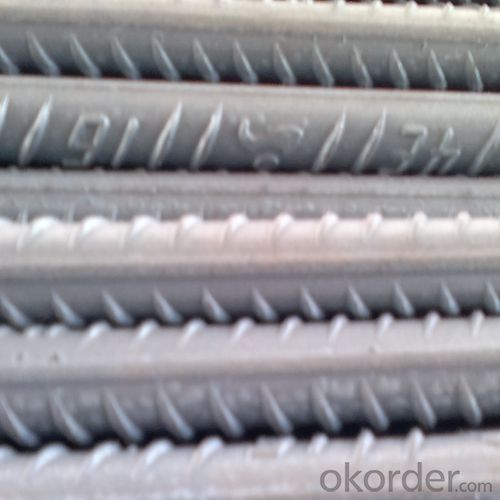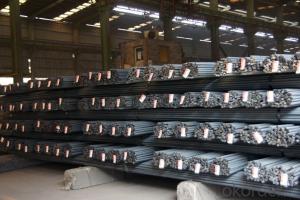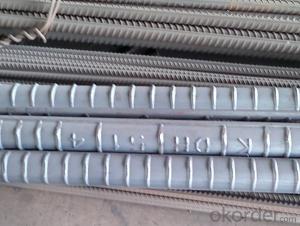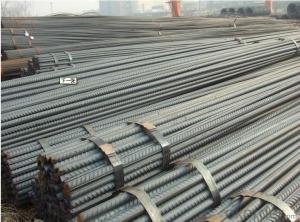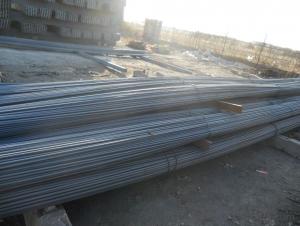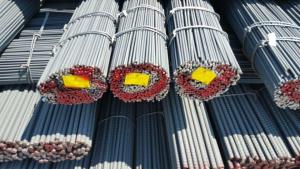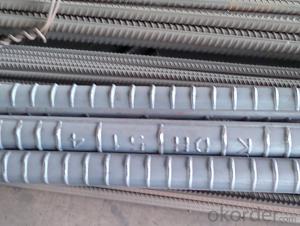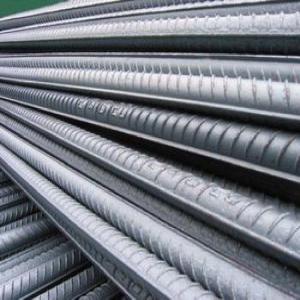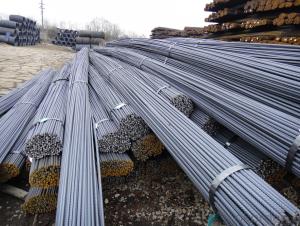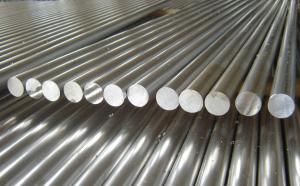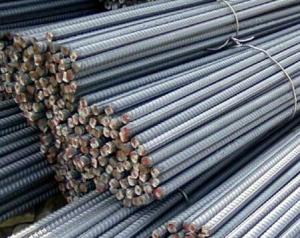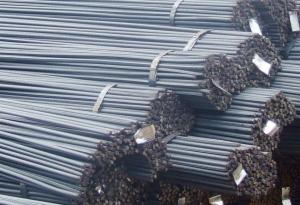Deformed Steel Bar Reinforced Deformed Steel Bar HRB400
- Loading Port:
- Tianjin
- Payment Terms:
- TT or LC
- Min Order Qty:
- 50 m.t.
- Supply Capability:
- 50000 m.t./month
OKorder Service Pledge
OKorder Financial Service
You Might Also Like
Product Description:
OKorder is offeringDeformed Steel Bar Reinforced Deformed Steel Bar HRB400 at great prices with worldwide shipping. Our supplier is a world-class manufacturer of steel, with our products utilized the world over. OKorder annually supplies products to European, North American and Asian markets. We provide quotations within 24 hours of receiving an inquiry and guarantee competitive prices.
Product Applications:
Deformed Steel Bar Reinforced Deformed Steel Bar HRB400 are ideal for structural applications and are widely used in the construction of buildings and bridges, and the manufacturing, petrochemical, and transportation industries.
Product Advantages:
OKorder's Deformed Steel Bar Reinforced Deformed Steel Bar HRB400 are durable, strong, and resist corrosion.
Main Product Features:
· Premium quality
· Prompt delivery & seaworthy packing (30 days after receiving deposit)
· Corrosion resistance
· Can be recycled and reused
· Mill test certification
· Professional Service
· Competitive pricing
Product Specifications:
Standard | GB | HRB400 | |
Diameter | 6mm,8mm,10mm,12mm,14mm,16mm,18mm,20mm, 22mm,25mm,28mm,32mm,36mm,40mm,50mm | ||
Length | 6M, 9M,12M or as required | ||
Place of origin | Hebei, China mainland | ||
Advantages | exact size, regular package, chemical and mechanical properties are stable. | ||
Type | Hot rolled deformed steel bar | ||
Brand name | DRAGON | ||
Chemical Composition: (Please kindly find our chemistry of our material based on HRB500 as below for your information)
Grade | Technical data of the original chemical composition (%) | ||||||
C | Mn | Si | S | P | V | ||
HRB400 | ≤0.25 | ≤1.60 | ≤0.80 | ≤0.045 | ≤0.045 | 0.04-0.12 | |
Physical capability | |||||||
Yield Strength (N/cm²) | Tensile Strength (N/cm²) | Elongation (%) | |||||
≥400 | ≥570 | ≥14 | |||||
Theoretical weight and section area of each diameter as below for your information:
Diameter(mm) | Section area (mm²) | Mass(kg/m) | Weight of 12m bar(kg) |
6 | 28.27 | 0.222 | 2.664 |
8 | 50.27 | 0.395 | 4.74 |
10 | 78.54 | 0.617 | 7.404 |
12 | 113.1 | 0.888 | 10.656 |
14 | 153.9 | 1.21 | 14.52 |
16 | 201.1 | 1.58 | 18.96 |
18 | 254.5 | 2.00 | 24 |
20 | 314.2 | 2.47 | 29.64 |
22 | 380.1 | 2.98 | 35.76 |
25 | 490.9 | 3.85 | 46.2 |
28 | 615.8 | 4.83 | 57.96 |
32 | 804.2 | 6.31 | 75.72 |
36 | 1018 | 7.99 | 98.88 |
40 | 1257 | 9.87 | 118.44 |
50 | 1964 | 15.42 | 185.04 |
Usage and Applications of HRB400 Deformed Steel Bar:
Deformed bar is widely used in buildings, bridges, roads and other engineering construction. Big to highways, railways, bridges, culverts, tunnels, public facilities such as flood control, dam, small to housing construction, beam, column, wall and the foundation of the plate, deformed bar is an integral structure material. With the development of world economy and the vigorous development of infrastructure construction, real estate, the demand for deformed bar will be larger and larger..
Packaging & Delivery of HRB400 Deformed Steel Bar:
Packaging Detail: products are packed in bundle and then shipped by container or bulk vessel, deformed bar is usually naked strapping delivery, when storing, please pay attention to moisture proof. The performance of rust will produce adverse effect.
Each bundle weight: 2-3MT, or as required
Payment term: TT or L/C
Delivery Detail: within 45 days after received advanced payment or LC.
Label: to be specified by customer, generally, each bundle has 1-2 labels
Trade terms: FOB, CFR, CIF
FAQ:
Q1: Why buy Materials & Equipment from OKorder.com?
A1: All products offered byOKorder.com are carefully selected from China's most reliable manufacturing enterprises. Through its ISO certifications, OKorder.com adheres to the highest standards and a commitment to supply chain safety and customer satisfaction.
Q2: How do we guarantee the quality of our products?
A2: We have established an advanced quality management system which conducts strict quality tests at every step, from raw materials to the final product. At the same time, we provide extensive follow-up service assurances as required.
Q3: How soon can we receive the product after purchase?
A3: Within three days of placing an order, we will begin production. The specific shipping date is dependent upon international and government factors, but is typically 7 to 10 workdays.
Images:
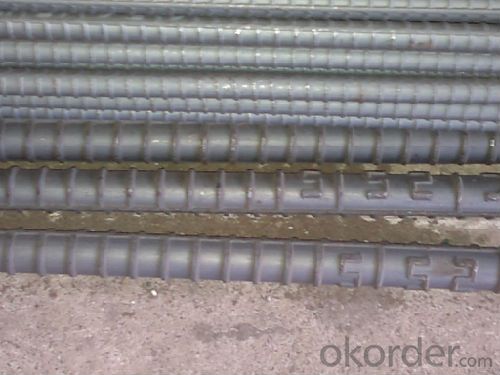
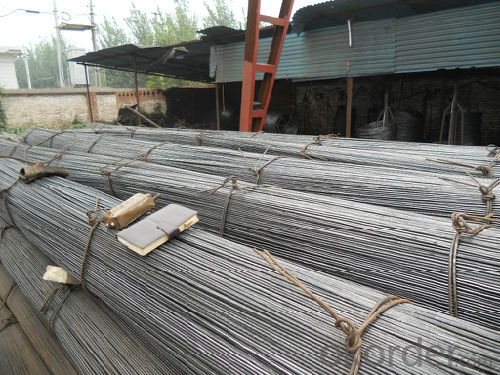
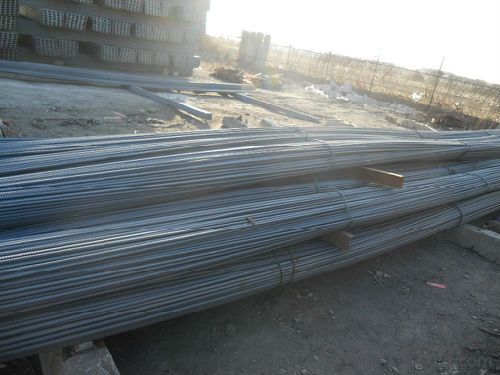
- Q: What are the common mistakes to avoid when installing steel rebars?
- Some common mistakes to avoid when installing steel rebars include improper placement or spacing of rebars, inadequate concrete cover, insufficient reinforcement overlap, incorrect bar bending or cutting, and neglecting to secure the rebars in place during concrete pouring. It is essential to follow the specifications and guidelines provided by structural engineers and adhere to industry standards to ensure proper reinforcement installation.
- Q: What are the common problems associated with steel rebars in concrete structures?
- Some common problems associated with steel rebars in concrete structures include corrosion, inadequate cover, improper placement, and improper anchorage. One of the most significant issues is corrosion. Steel rebars are susceptible to corrosion when exposed to moisture and oxygen, especially in harsh environments such as coastal areas or regions with high humidity. Corrosion can weaken the rebars, leading to structural deterioration and reduced load-bearing capacity of the concrete structure. Another problem is inadequate cover, which refers to insufficient concrete cover over the rebars. Inadequate cover can occur due to poor construction practices or design errors. When rebars are not adequately covered, they are more prone to corrosion as they are exposed to external elements. Additionally, inadequate cover can compromise the structural integrity of the concrete, especially in terms of fire resistance and durability. Improper placement of rebars can also cause problems in concrete structures. If rebars are not properly aligned or spaced according to the design specifications, it can result in weak sections within the concrete. This can lead to uneven load distribution and potential structural failure. Improper placement can also hinder the effectiveness of rebars in reinforcing the concrete, compromising the overall strength of the structure. Improper anchorage of rebars is another common problem. Adequate anchorage is crucial to ensure that the rebars effectively transfer the load between different sections of the concrete structure. If the rebars are not properly anchored, they may slip or pull out under stress, reducing the structural strength and stability of the concrete. To mitigate these problems, it is essential to follow proper construction practices and adhere to design specifications. This includes ensuring proper concrete cover, correct placement and alignment of rebars, adequate anchorage, and using corrosion-resistant rebars or protective coatings in corrosive environments. Regular inspections and maintenance are also necessary to detect and address any potential issues with steel rebars in concrete structures.
- Q: How do steel rebars improve the durability of concrete structures?
- Concrete structures can be made more durable in various ways through the use of steel rebars. Firstly, steel rebars act as reinforcement, adding strength and stability to the structure. When combined with concrete, the high tensile strength of steel rebars helps resist cracking and prevent collapse under heavy loads or seismic activities. Secondly, steel rebars assist in controlling the formation and spread of cracks in concrete structures. Concrete is strong in compression but weak in tension, making it prone to cracking under tensile forces. By strategically placing steel rebars within the concrete, cracks are minimized and prevented from spreading, thereby improving the overall durability of the structure. Furthermore, steel rebars enhance the resistance of concrete structures against corrosion. The highly alkaline nature of concrete forms a protective layer around the steel rebars, preventing rust. This corrosion resistance ensures the rebars maintain their structural integrity over time, reducing the risk of deterioration and enhancing the longevity of the concrete structure. Moreover, steel rebars also increase the fire resistance of concrete structures. With their high melting point, steel rebars can withstand high temperatures, preventing the concrete from losing its structural integrity during a fire. This additional fire resistance ensures the stability and safety of the concrete structure in case of a fire, further enhancing its durability. In conclusion, the inclusion of steel rebars significantly enhances the durability of concrete structures by providing added strength, controlling cracks, improving corrosion resistance, and increasing fire resistance. These advantages contribute to the longevity and safety of concrete structures, making them more reliable and sustainable in the long term.
- Q: Are steel rebars suitable for use in structures with high wind loads?
- Structures with high wind loads can benefit from the use of steel rebars. Also known as reinforcing bars, steel rebars are commonly utilized in construction to provide strength and stability to reinforced concrete structures. Their purpose is to withstand significant tensile forces and play a crucial role in maintaining the structural integrity of buildings, particularly in areas prone to high wind loads. Steel rebars possess several advantages that render them suitable for structures with high wind loads. Firstly, steel exhibits exceptional tensile strength, enabling it to resist the forces generated by wind loads. Unlike materials such as timber or concrete, steel rebars possess remarkable ductility, allowing them to absorb and redistribute the energy produced by wind-induced vibrations. Secondly, steel rebars demonstrate remarkable durability and resistance to corrosion. This characteristic is vital for structures exposed to harsh weather conditions, including strong winds. Utilizing steel rebars mitigates the risk of structural deterioration or weakening over time caused by wind-induced stresses. Furthermore, steel rebars offer ease in molding and shaping, accommodating the specific design requirements of the structure. This flexibility empowers engineers to create and construct buildings capable of withstanding various wind loads experienced in different regions. In conclusion, due to their high tensile strength, durability, and resistance to corrosion, steel rebars are an ideal choice for structures with high wind loads. They provide the necessary reinforcement to ensure the longevity and safety of the structure under challenging wind conditions.
- Q: How do steel rebars affect the electrical conductivity of a structure?
- The electrical conductivity of a structure is not significantly influenced by steel rebars. Despite steel being an excellent conductor of electricity, the presence of rebars in a structure does not have a substantial effect on its overall electrical conductivity. This is because the rebars are typically surrounded by concrete, which is a poor conductor of electricity. Consequently, the concrete acts as an insulator, preventing the flow of electrical current through the rebars. However, it is important to note that if there are any direct electrical connections or installations attached to the steel rebars, such as grounding systems, these can influence the electrical conductivity within that particular area. In conclusion, the presence of steel rebars in a structure does not significantly impact its overall electrical conductivity.
- Q: How do steel rebars contribute to sustainable construction practices?
- There are several ways in which steel rebars contribute to sustainable construction practices: 1. Enhanced durability: Steel rebars possess a high level of durability and have a long lifespan, which results in less frequent replacements or repairs. This helps in minimizing the generation of waste and conserving valuable resources. 2. Advancement in structural strength: Steel rebars offer superior strength and structural integrity to reinforced concrete. This enables the construction of tall buildings and structures, reducing the need for land consumption and encouraging vertical growth in urban areas. 3. Energy-conscious production: Steel rebars are manufactured using energy-efficient processes, reducing the carbon footprint associated with their production. Moreover, their use in reinforced concrete structures improves energy efficiency by reducing the requirement for additional insulation materials. 4. Recyclability: Steel rebars are entirely recyclable, meaning they can be melted down and reused in new construction projects. This diminishes the demand for new steel, conserving natural resources and reducing greenhouse gas emissions related to steel production. 5. Waste reduction: The application of steel rebars in reinforced concrete structures reduces the quantity of construction and demolition waste generated. By providing a strong and long-lasting structure, it minimizes the necessity for frequent renovations or replacements, ultimately reducing waste generation over time. 6. Strengthened seismic resistance: Steel rebars enhance the ability of buildings and structures to withstand earthquakes and other natural disasters, thus improving their seismic resistance. This ensures the safety of occupants and reduces the post-disaster reconstruction efforts, contributing to sustainable development. Overall, the use of steel rebars in construction promotes sustainability by reducing waste, conserving resources, improving energy efficiency, and enhancing the durability and resilience of structures.
- Q: Can steel rebars be used in the construction of hospitals?
- Yes, steel rebars can be used in the construction of hospitals. Steel rebars are commonly used in reinforced concrete structures to provide strength and stability. In hospital construction, where safety and durability are crucial, steel rebars are essential for reinforcing concrete foundations, columns, beams, and other structural elements. They help ensure the structural integrity of the hospital building, making it resilient and capable of withstanding various loads and potential hazards.
- Q: What is the role of steel rebars in load-bearing walls?
- Steel rebars are used in load-bearing walls to provide reinforcement and structural stability. They enhance the strength and durability of the walls, allowing them to bear heavy loads and resist bending or cracking. The rebars are embedded within the concrete, creating a reinforced concrete structure that can support the weight of the building and distribute the load evenly throughout the wall.
- Q: How do steel rebars affect the overall sound insulation of a building?
- Steel rebars have minimal impact on the overall sound insulation of a building. While they may conduct sound to a small extent due to their rigid nature, the primary factors affecting sound insulation are the materials used for walls, floors, and ceilings, as well as insulation materials. Steel rebars are typically embedded within concrete structures and do not significantly contribute to sound transmission between spaces.
- Q: How do steel rebars affect the durability of a structure?
- Steel rebars greatly enhance the durability of a structure by providing reinforcement and strength to withstand external forces, such as tension and compression. They improve the structural integrity, increase resistance to cracking and bending, and ensure long-term stability, making the structure more resistant to corrosion and structural failure.
Send your message to us
Deformed Steel Bar Reinforced Deformed Steel Bar HRB400
- Loading Port:
- Tianjin
- Payment Terms:
- TT or LC
- Min Order Qty:
- 50 m.t.
- Supply Capability:
- 50000 m.t./month
OKorder Service Pledge
OKorder Financial Service
Similar products
Hot products
Hot Searches
Related keywords
